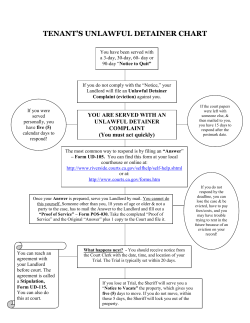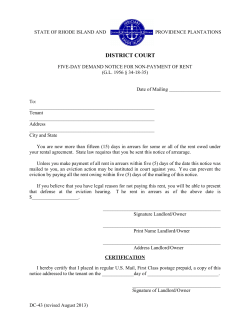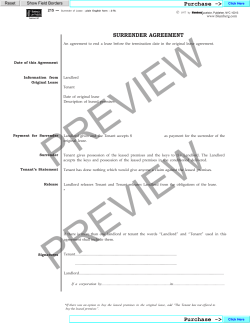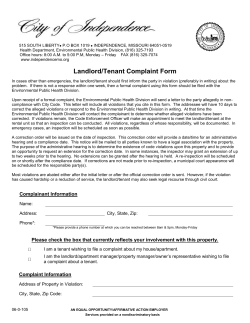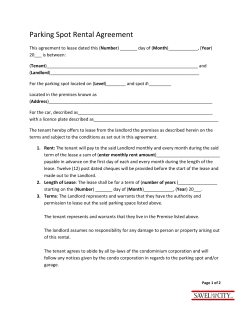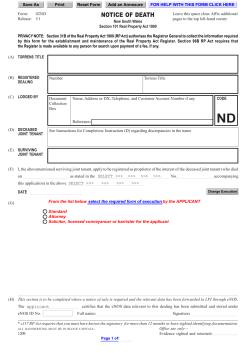
This brochure is intended only as a basic
This brochure is intended only as a basic informational guide concerning tenant evictions and the role and requirements of the Douglas County Sheriff's Office in such actions. You are responsible for conducting your own legal research, properly applying state law to your situation, obtaining required forms and properly completing them. Please keep in mind that all Douglas County Sheriff's Office employees are prohibited by law from giving legal advice (C.R.S. 30-10-520), but otherwise will make every effort to provide information and assistance. You should consult an attorney for legal advice. The eviction process is referred to in the Colorado Revised Statutes as Forcible Entry and Detainer, commonly referred to as an "F.E.D." action and set forth in Title 13, Article 40 of the Colorado Revised Statutes (C.R.S.). State statutes are available at your local library or on the World Wide Web. You may want to save these web sites on your browser under favorites. Go to the Colorado Judicial Branch web site at http://www.courts.state.co.us Look to the right side of the page for the link Colorado Revised Statutes. This link should take you to the web site: Click to select Colorado Statutes, then type in the search window 13-40-101, and click Go (upper left). BEGINNING THE PROCESS Most eviction actions are initiated because a tenant has failed to make the rent payments. There are other causes, however, all of which are set forth in 13-40-104 and 13-40-107.5 C.R.S. The specifics of each person’s situation will probably be governed either by the provisions of a lease or the terms of a monthto-month tenancy. date the summons was issued (13-40-111 C.R.S.). When the landlord has decided to proceed with an eviction action, they must complete a written notice to the tenant such as a Demand for Compliance, Right to Possession or a Notice to Quit. The notice must set forth the grounds for the landlord's demand for possession of the property, the date and time that the tenancy will terminate, and must be signed by the landlord or his agent or attorney. The amount of time between the time of service and the termination varies based on the type and length of the tenancy or reason for termination. The most common length of time is 3 days for failure to pay rent. The specifics are covered by 13-40104 and 13-40-107 C.R.S. The requirements of the written demand are in 13-40-106 C.R.S. This notice may be served on the tenant, other occupant, or a relative living there over the age of 15. If no one is present the Notice may be posted in a conspicuous place, such as on the front door. Service requirements are in 13-40108 C.R.S. It is recommended that language such as "and all other occupants" be included on all paperwork, in addition to the names of tenants or persons that are known. This summons and complaint is then served on the tenant(s) (now defendant). A proper legal service must be made on each tenant. Do not try to save money by only serving one person if there are multiple tenants, as the court will not have jurisdiction over tenants that are not served. A private process server, the Sheriff's Office, or a person over the age of 18 who is not a party to the action can make service. Service must be made at least 5 business days prior to the court date. If service on the defendant or a relative living at the residence who is at least 18 cannot be made "after having made all diligent effort,” the process may be posted. However, if posted, the landlord (now plaintiff) must have mailed a copy of the Summons and Complaint to the defendant no later than the day following the day the complaint is filed (not the day following service). It is a good practice to mail the copy as a matter of course because the actual manner of service probably won't be known for several days. If the mail provision is immediately complied with, either type of service will be legal. NEXT - THE SUMMONS AND COMPLAINT If the tenants do not move out in accordance with the written notice, an action under this article is initiated by filing with the Douglas County Court a complaint requesting recovery of the property. Past-due rent and other specified claims may also be included as part of the complaint (13-40-110 C.R.S.). The court clerk or your attorney will then issue a summons to be served on the tenant(s). The summons will command the tenant's appearance in court, no less than 5 business days nor more than 10 calendar days from the THE COURT HEARING If at the hearing the court finds that the defendant has committed an unlawful detainer, judgment will be entered for possession of the property in favor of the plaintiff. If personal service was made, the court may also award a money judgment for such things as back rent, damage, attorney's fees, etc. If the service was by posting, the court will not award any money but will still issue judgment for possession. In that case, the money judgment may be obtained later through a separate action, such as a Small Claims Court suit (13-40-115 and 13-40-123 C.R.S.) or a continuance of the original civil action to obtain personal service. If the defendant wins, he is entitled to a judgment for his costs (13-40-116 C.R.S.). deputy executing a writ is also immune from civil and criminal liability. The defendant can appeal a decision against him to the district court. The court may require an appeal bond as well as a deposit of rent (13-40117, and 13-40-118 C.R.S.). Physical labor required for moving the tenant's belongings is arranged, provided, and paid for by the landlord. Under normal conditions, sufficient personnel must be present to complete the eviction in 2 hours. THE WRIT OF RESTITUTION Assuming that the landlord prevails in court and that there is no appeal filed, the court clerk will issue a Writ of Restitution after the passage of 48 hours. This stay is required by statute and cannot be waived. Its purpose is to allow the defendants to move out on their own. If this happens, the landlord does not have to obtain the Writ of Restitution as the defendant's leaving has restored the property to the possession of the landlord. Once the Writ of Restitution has been obtained, it must be brought to the Sheriff's Office Civil Section for execution. If your eviction has progressed to this stage, obtain our brochure Sheriff’s Requirements For Writs Of Restitution (A Planning Guide For Successful Execution). This is the only stage of the process that requires the involvement of the Sheriff. The Civil Division will post a courtesy copy of the Writ along with a warning notice from the Sheriff’s Office telling the tenant that an eviction is imminent. In most cases, the notice will cause the tenant to move on their own. Should the tenant not move the landlord must schedule an eviction with the Sheriff’s Office. All of the belongings of the tenant must be removed from the property and deposited along the nearest public right-of-way. Under Colorado law, the deputy is immune from civil liability for any damage to a tenant’s personal property that was removed. And a landlord who complies with the lawful direction of the THE EVICTION PROCESS SHERIFF’S FEES FOR SERVICE OF PROCESS Written Notice $35.00 + mileage Summons & Complaint (each defendant) $35.00 + mileage Writ of Restitution $135.00 + mileage REQUIRED FORMS AND INSTRUCTIONS To obtain additional information, court forms, and instructions, visit the Colorado State Judicial Branch’s web site. http://www.courts.state.co.us/Forms/Forms_ List.cfm?Form_Type_ID=28 Forms can be downloaded either as a Microsoft Word document (.doc) or as an Adobe Acrobat file (.pdf). You may complete a form on line or you may print it and type or print legibly in black ink. Read the Instructions for Forcible Entry and Detainer (JDF 100) carefully to determine what forms you may need and to better understand the court process. Another good web site for both tenant and landlord can be found at http://www.coloradolegalservices.org. Look for the topic Housing, then Eviction. Douglas County Sheriff’s Office Civil Section 4000 Justice Way, Suite 2213 Castle Rock, CO 80109 Phone (303) 660-7527 Fax (303) 663-0688 http://www.dcsheriff.net Revised 05/03/2011
© Copyright 2025
